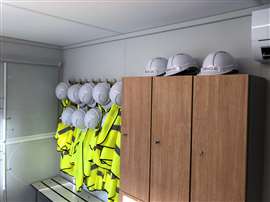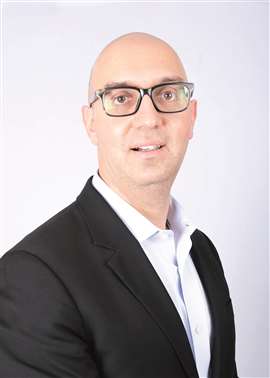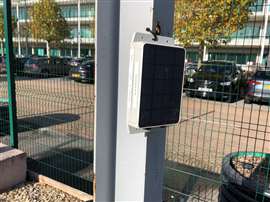Why construction is ‘tired’ of seeing tech that isn’t available to use
08 March 2024
The words ‘construction technology’ may conjure images of autonomous machines working on sites, big screens displaying critical information in fancy graphics, or perhaps a robotic surveying machine moving back and forth across the ground, or even through the air.
 Oracle worked hard to ensure its Technology Lab in Reading, UK, looks and feels like a real construction site
Oracle worked hard to ensure its Technology Lab in Reading, UK, looks and feels like a real construction site
Much of this construction technology exists at the concept stage and such innovations regularly appear in videos and news articles online.
But most are not yet commercially available – and even where they are, the percentage of the industry using such advanced tech is relatively small.
On visiting the Oracle Technology Lab in Reading, UK, one of the things that is striking is how grounded it all appears – how it resembles a real construction site and how the technology on display could be used at a real site tomorrow.
It’s the opposite of the flashing lights and razzmatazz that one might expect and, as it turns out, that’s exactly how it was planned.
“I’ve worked in the industry for almost two decades. When I used to go to these kinds of [technology] spaces, I felt that I couldn’t relate them to my day-to-day job. I would go to these things and go, ‘oh, that’s cool, but how am I going to implement that?” says Dr Burcin Kaplanoglu, vice president of innovation and co-founder of Oracle Industry Labs.
“Our focus is things that can turn into products and solutions within 12 to 16 months. I think that is one of the key reasons why the industry responded to these labs so well; because when people walk in and see the technologies, they realise, I can use this next week, or in three months. They’re not going to wait for three years,” he adds.
Some of the technology on display were devices that tracked someone’s health statistics to ensure they are fit and healthy for work, sensors that send alerts if a worker is in a location they shouldn’t be, such as an unsafe area, and technology that helps prevent theft and losing equipment.
Oracle currently has three Construction Technology Labs: in Reading, UK, Chicago, US, and Sydney, Australia. There are apparently no current plans to add a new lab to the portfolio in another region (Asia would surely make sense), but Kaplanoglu believes the key to the success of the three labs is the fact that the technology they display is not something that may – or may not – be available in the distant future.
“A lot of the things [visitors to the lab] experienced, things we developed, are now commercially available or will be available in the next 12 to 16 months. And that really helped the lab because our industry is tired of seeing things which are available five years from now, ten years from now; we want to get things that we can use today.”
Not interested in cool
 Dr. Burcin Kaplanoglu
Dr. Burcin Kaplanoglu
There’s no doubt that the construction sector has increased its adoption of technology in recent years. However, what’s also not in doubt is that this rate could be higher and is mainly being driven by the larger contractors rather than smaller and medium-sized ones.
Cost, of course, is an issue, as is scalability – if adopting technology means a business has to make major changes to operate it effectively then it’s probably not going to happen. This, says Kaplanoglu, can often be the case with some technology that is “awesome” but practically is unlikely to happen. Following on from this train of thought he adds, “We are looking for likes, not cool.
“Because what happens is, when people say it’s cool, they’re not actually going to use it. When they say, ‘I like it’, they’re going to use it. To be very specific, we can look at remote site monitoring. Six years ago, we started doing a lot of things with cameras and an early version of computer vision, recognizing objects, and the industry was, ‘that’s cool’.
“Well, fast forward six years and they went from cool to like, and now there is massive adoption of those things. The restrictions we had during the pandemic really accelerated and forced people to look into these technologies much more seriously.”
Increasing engagement in technology
One of the main purposes of the labs is to increase engagement with the industry, for contractors, manufacturers and others in the sector to come to the labs and interact with Oracle’s staff and to understand the technology better.
Talking about the sensors that are on display at the lab to track location, Kaplanoglu makes the point that adoption of them increased when the workers using them properly understood them. “These sensors that workers wear, it will track zones. We made sure they understood this is not tracking your location to the exact millimetre,” he says.
“I don’t know if you are sitting for an hour or you are physically doing something for an hour, I can’t see it, but I know you’re in that zone. So, if there is a safety incident, I can go find you, and I know if you are in a zone you’re not supposed to be. We trained people to educate them and say it doesn’t know your exact location, it doesn’t work outside this area, it uses a mesh network.”
 Technology that helps sets up a ‘mesh’ network - if someone with a wrist device goes past this point then an alert is triggered
Technology that helps sets up a ‘mesh’ network - if someone with a wrist device goes past this point then an alert is triggered
It’s an obvious point, but when those working on construction sites understand what technology does and why it benefits them and the job, then adoption increases. As well as displaying technology that is commercially available now, or in the near future, this education could be key to construction accelerating its technology journey.
“I don’t think we spend enough time explaining these technologies to the workers and what the benefits are,” says Kaplanoglu.
“We spend a lot of time explaining to companies what the benefits are. We need to go further into the next layer, right? We need to really have people understand what it is.”
Brought To You By
|
STAY CONNECTED



Receive the information you need when you need it through our world-leading magazines, newsletters and daily briefings.
CONNECT WITH THE TEAM








